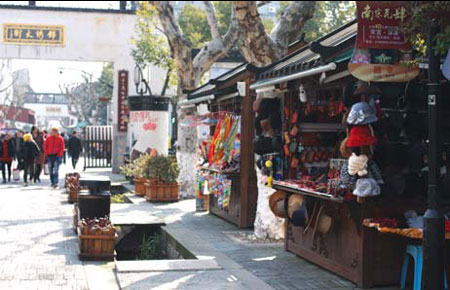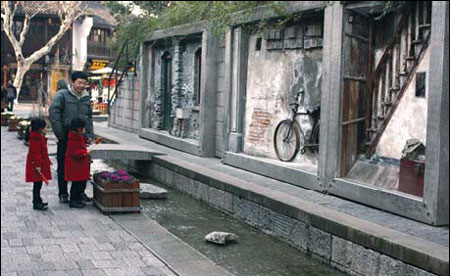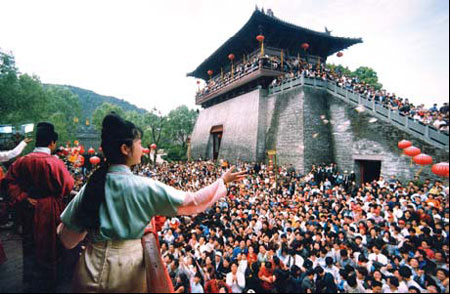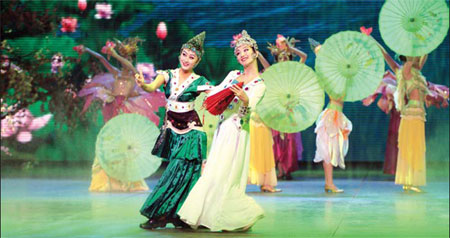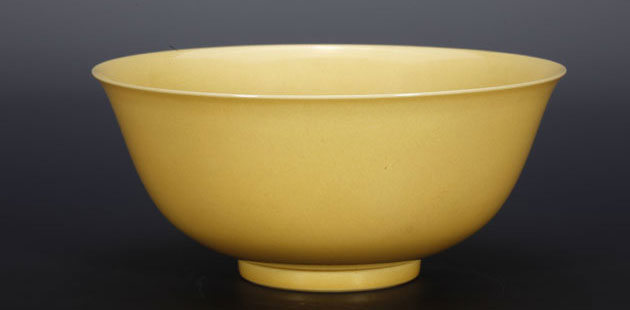Hangzhou: Portal to the past
Updated: 2012-02-24 08:10
By Xu Xiao (China Daily)
|
|||||||||||
|
Vendors sell a variety of wares along the Song Dynasty Imperial Street. Xu Xiao / China Daily |
|
A father and his twin daughters spend their leisure hours on peaceful Hefang Street. Xu Xiao / China Daily |
|
A young girl throws a wedding ball to the crowd below at Song City. The man who catches it will play her husband for the day in a mock wedding. Provided to China Daily |
|
The Legend of Romance is a one-hour gala telling the history and legends of the city. |
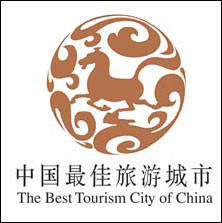
Though many Chinese cities may seem on the surface to be labyrinth of concrete and steel, travelers need only a deeper look at a city's culture and history to find what makes it unique.
Hangzhou, called Lin'an when it was the capital of the Southern Song Dynasty (1127-1279) from 1138 to 1276, is reliving its glory days by merging its rich history with the city's modern prosperity.
The city's Southern Song Imperial Street, a re-creation of what Hangzhou looked like seven centuries ago, is a popular destination for tourists and natives alike.
A 20-minute walk from the central business district near scenic West Lake, the street was rebuilt in 2008 to demonstrate the vibrant commerce and colorful life of the folk people in the past dynasty.
The 4.3-km-long pedestrian street is the crossroads where the past and present merge.
Along a gently flowing brook, there are specialized shops selling silk, tea and silver. Some chain hotels are built in the ancient style to remind people that they are staying in a historical place. Vendors sit peacefully by their grocery stalls as if they were taking a break instead of doing a business.
About every 100 meters there is an arch emblazoned with the words "Southern Song Imperial Street" in Chinese characters.
The Southern Song relic exhibition hall near the street is hard to miss. A glass cover protects the original ruins of the "imperial street" that was discovered in 2006. Standing on the wooden steps, you can see a stone path under the glass cover, which helps one imagine the city's prosperous past some 700 years ago.
At the end of the imperial streets, you will see Hefang Street. Opened in 2002, it is considered to be the historical street in Hangzhou most representative of the city's cultural background.
The recovered pedestrian street is mainly a re-creation of folk scenes from the late Qing Dynasty (1644-1911) and the period of the Republic of China (1912-1949).
Hefang Street has become an essential destination for new tourists to the city. Here they can buy silk products, tea and local dim sum as souvenirs or just take a sip of coffee in a modern chain restaurant like McDonald's. Young lovers on a tight budget can spend a lazy afternoon browsing the Taiwan gourmet street or just stroll holding hands.
At night, Hefang bustles with life but is no less peaceful than during the day. Locals take to the street for after-dinner exercise, to chat with townspeople, or to walk smartly dressed dogs. Shy puppy lovers walk hand in hand among a tide of people, smiling in the twinkling streetlight.
If you have more time, visit Song City, another scenic area showcasing Southern Song Dynasty culture and legends.
About a 30-minute drive from the city center, the tourist attraction was built based on the renowned painting Along The River During Qingming Festival by Song Dynasty artist Zhang Zeduan. It not only recreates the scenes of daily life depicted in the painting but also includes some features designed according to the legendary novel Outlaws of the Marshes, considered one of the four greatest Chinese classical works.
The exhibit features soldiers in Song-style clothes holding an arrest warrant under the gate tower, which makes visitors feel as if a notorious bandit could be walking among them.
A beauty, the daughter of a ministry councilor surnamed Wang, stands each day on a balcony. She sometimes throws a wedding ball to the onlookers below. The man who catches the ball will be her "husband" for the day and will ride on a horse leading a sedan carrying his "bride" around the Song City with a big band in tow.
It is also recommended that visitors check out a live show called The Legend of Romance. The one-hour gala is one of Hangzhou's most popular shows and has been seen by 3 million viewers each year since it began in 1996.
It has five episodes, which respectively show the origin of the Chinese people, demonstrate the imperial dances of the Song royal palace, relive battle scenes from the Southern Song Dynasty, tell the legendary love story of Lady White Snake as well as the tale of Liang Shanbo and Zhu Yingtai, a popular Chinese story similar to Romeo and Juliet.
Spectators will definitely be dazzled by the splendid three-dimensional stage scenes and the nicely matched colors. After immersion in the perfect blend of audio and visual effects, the audience will be lured through a portal to the past to experience the pride and pains of history.
(China Daily 02/24/2012 page7)
Hot Topics
Wu Ying, iPad, Jeremy Lin, Valentine's Day, Real Name, Whitney Houston, Syria,Iranian issue, Sanyan tourism, Giving birth in Hong Kong, Cadmium spill, housing policy
Editor's Picks
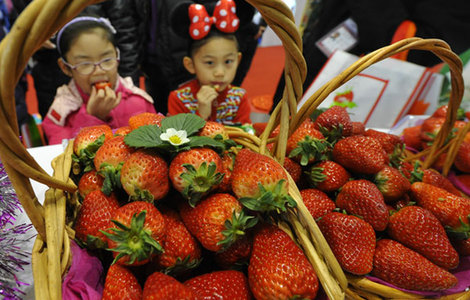
|
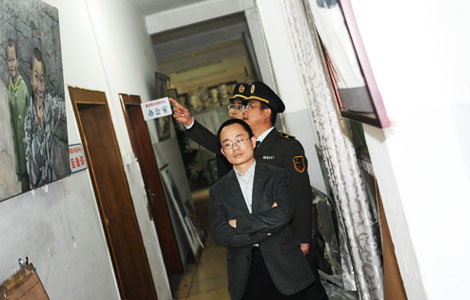
|

|

|

|

|
